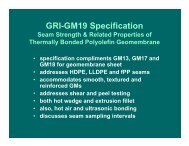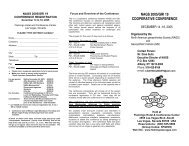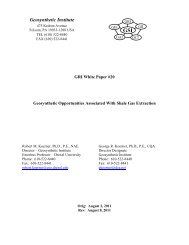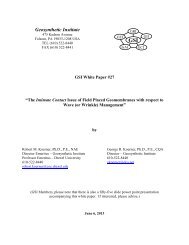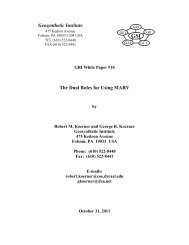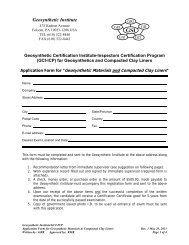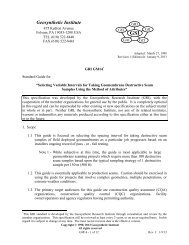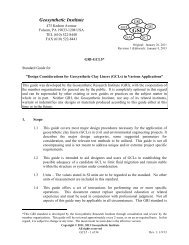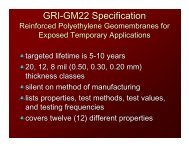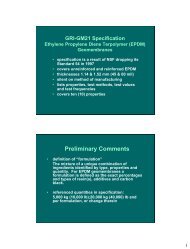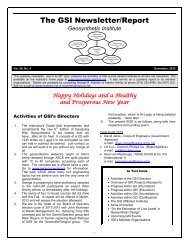GRI-GT13(a) - The Geosynthetic Institute
GRI-GT13(a) - The Geosynthetic Institute
GRI-GT13(a) - The Geosynthetic Institute
Create successful ePaper yourself
Turn your PDF publications into a flip-book with our unique Google optimized e-Paper software.
<strong>GRI</strong>-<strong>GT13</strong>(a) Specification<br />
Geotextile Separation for Roadways<br />
(ASTM Test Method Based)<br />
• placed between subgrade soil and an<br />
overlying aggregate layer<br />
• separation prevents mixing and intrusion<br />
• meant for firm subgrades; e.g., paved roads<br />
• three levels of installation survivability<br />
• survivability guide is also included<br />
• augments AASHTO M288 specification
Preliminary Comments<br />
• includes wovens and nonwovens<br />
• silent on type of polymer<br />
• subgrade evaluated using CBRtest<br />
value; i.e., CBR > 3.0 (soaked)<br />
or CBR > 8.0 (unsoaked)<br />
• values are MARV; except AOS (its<br />
MaxARV) and UV (its min. ave.)
Regarding MARV<br />
• minimum average roll value<br />
• accommodates variation in GT<br />
manufacturing properties<br />
• statistically it’s the “μ-2σ” value<br />
• MaxARV is the “μ+2σ” value<br />
• procedure shown in next screens
MD<br />
Roll<br />
length<br />
XMD<br />
Field Sampling to Obtain<br />
Average Roll Value<br />
SAMPLE<br />
≈ 1.0 m<br />
Roll<br />
Width<br />
1.0 m<br />
S-1<br />
S-2<br />
S-3<br />
Sample<br />
XMD<br />
S-4<br />
MD<br />
S-5<br />
S-6<br />
S-7<br />
Take Specimens from above Sample<br />
and Test as Required
637N<br />
624<br />
631<br />
620<br />
618<br />
633<br />
641<br />
629<br />
652N<br />
641<br />
639<br />
657<br />
642<br />
651<br />
641<br />
646<br />
642N<br />
646<br />
658<br />
641<br />
635<br />
642<br />
658<br />
646<br />
637N<br />
643<br />
628<br />
662<br />
646<br />
633<br />
619<br />
638<br />
627N<br />
615<br />
621<br />
616<br />
619<br />
621<br />
622<br />
620<br />
643N<br />
627<br />
652<br />
629<br />
632<br />
641<br />
662<br />
641<br />
1<br />
2<br />
3<br />
4<br />
5<br />
6<br />
7<br />
Average =<br />
6<br />
5<br />
4<br />
3<br />
2<br />
1<br />
Roll Number<br />
Test<br />
Number<br />
This is MARV Value!
Test Properties Included<br />
1. grab tensile strength<br />
2. trapezoidal tear strength<br />
3. CBR puncture strength<br />
4. Permittivity (Flow Rate)<br />
5. apparent opening size<br />
6. UV stability by Xenon Arc
1. Grab Tensile Response<br />
• follows ASTM D4632<br />
• 10 specimens MD & XMD across width<br />
• 100 mm wide; gripped in center 25 mm<br />
• must avoid slippage or grip failure<br />
• record maximum strength in kN (lb)<br />
• elongation is not included<br />
• develop MARV for strength and<br />
compare to spec
D4632 - Grab Tensile Test<br />
[Evaluates Strength (and Elongation) at Failure]
2. Trapezoidal Tear Strength<br />
• follows ASTM D4533<br />
• tear propagates from an initial cut<br />
• maximum value is recorded<br />
• 10 specimens in MD and XMD<br />
across roll width<br />
• take average value of lowest<br />
• develop MARV and compare to<br />
specification value
D4533 - Trapezoidal Tear Strength<br />
(Evaluates the Maximum Value)
3. CBR Puncture Strength<br />
• California Bearing Ratio (CBR) is a soil<br />
strength test adopted for geosynthetics<br />
• follows ASTM D6241 using the same<br />
device…. modified with flanges<br />
• probe is 50 mm (2.0 in.) diameter<br />
• container is 150 mm (6.0 in.) diameter<br />
• 10 specimens across roll width<br />
• puncture strength is obtained<br />
• develop MARV and compare to spec
D6241 - Puncture (CBR) Strength<br />
[Evaluates Strength at Rupture (and Accompanying Deformation)]
4. Permittivity (Water Flow Rate)<br />
• follows ASTM D4491<br />
• uses deaired water (≤ 6 ppm<br />
dissolved oxygen)<br />
• measures flow rate/unit area<br />
• constant head of 50 mm (2.0 in.)<br />
• results in permittivity, ψ = (k)(t)<br />
• value must be ≥ 0.02 sec -1
ASTM D4491 – Water Flow Rate (Permittivity) Device
Specimen<br />
Being<br />
Placed<br />
Adjusting<br />
Hydraulic<br />
Head<br />
Measuring<br />
Flow Rate
5. Apparent Opening Size<br />
• its dry bead sieving, per ASTM D4751<br />
• AOS is often called EOS<br />
• it’s a maximum value, i.e., “MaxARV”<br />
• converted to either 0 95 in mm, or<br />
equivalent U. S. sieve size<br />
• values must be ≤ 0.60 mm (0.024 in.)<br />
• this is equivalent to #30 sieve size
ASTM D4751<br />
AOS Test<br />
Sieves<br />
Being<br />
Shaken<br />
Bottom<br />
Pan With<br />
Beads That<br />
Passed Fabric
6. Ultraviolet Resistance<br />
• follows ASTM D4355 (Xenon Arc)<br />
• 500 hours exposure<br />
• cycled at 90 min. light; 30 min.<br />
light and water spray<br />
• 50 mm strip tensile per D5035<br />
• 5 MD and 5 XMD and values<br />
averaged together<br />
• min. ave. ≥ 50% strength retained
Typical<br />
Xenon Arc<br />
Weatherometer
Interior Chamber<br />
of Xenon Arc<br />
Weatherometer
ENGLISH UNITS<br />
Property<br />
ASTM Test<br />
Unit<br />
Elongatio<br />
n<br />
< 50%<br />
Elongation<br />
≥ 50%<br />
Grab Tensile Strength<br />
D 4632<br />
lb<br />
315<br />
203<br />
Trapezoid Tear Strength<br />
D 4533<br />
lb<br />
112<br />
79<br />
CBR Puncture Strength<br />
D 6241<br />
lb<br />
630<br />
440<br />
Permittivity<br />
D 4491<br />
sec-1<br />
0.02<br />
0.02<br />
Table 1(a) - Geotextile Properties Class 1 (High Survivability) (1) 50<br />
Apparent Opening Size<br />
D 4751<br />
in.<br />
0.024 0.024<br />
Ultraviolet Stability (2) D 4355 % Ret. @ 500 hrs 50<br />
50<br />
Property<br />
ASTM Test<br />
Unit<br />
Elongation<br />
< 50%<br />
Elongation<br />
≥ 50%<br />
Grab Tensile Strength<br />
D 4632<br />
lb<br />
248<br />
158<br />
Trapezoid Tear Strength<br />
D 4533<br />
lb<br />
90<br />
56<br />
CBR Puncture Strength<br />
D 6241<br />
lb<br />
500<br />
320<br />
Permittivity<br />
D 4491<br />
sec-1<br />
0.02<br />
0.02<br />
Table 1(b) - Geotextile Properties Class 2 (Moderate Survivability) (1) 50<br />
Apparent Opening Size<br />
D 4751<br />
in.<br />
0.024 0.024<br />
Ultraviolet Stability (2) D 4355 % Ret. @ 500 hrs 50<br />
Table 1(c) - Geotextile Properties Class 3 (Low Survivability) (1)<br />
Property<br />
ASTM Test<br />
Unit<br />
Elongation<br />
< 50%<br />
Elongation<br />
≥ 50%<br />
Grab Tensile Strength<br />
D 4632<br />
lb<br />
180<br />
113<br />
Trapezoid Tear Strength<br />
D 4533<br />
lb<br />
68<br />
41<br />
CBR Puncture Strength<br />
D 6241<br />
lb<br />
380<br />
230<br />
Permittivity<br />
D 4491<br />
sec-1<br />
0.02<br />
0.02<br />
Apparent Opening Size<br />
D 4751<br />
in.<br />
0.024<br />
0.024<br />
Ultraviolet Stability (2) D 4355 % Ret. @ 500 hrs 50<br />
Notes:<br />
(1) All values are MARV except UV stability; it is a minimum value and AOS which is a maximum value.<br />
(2) Evaluation to be on 2.0 inch strip tensile specimens after 500 hours exposure.
Table 2(a) - Geotextile Properties Class 1 (High Survivability) (1)<br />
SI METRIC UNITS<br />
Property<br />
ASTM Test<br />
Unit<br />
Elongation<br />
< 50%<br />
Elongation<br />
≥ 50%<br />
Grab Tensile Strength<br />
D 4632<br />
N<br />
1400<br />
900<br />
Trapezoid Tear Strength<br />
D 4533<br />
N<br />
500<br />
350<br />
CBR Puncture Strength<br />
D 6241<br />
N<br />
2800<br />
2000<br />
Permittivity<br />
D 4491<br />
sec-1<br />
0.02<br />
0.02<br />
Apparent Opening Size<br />
D 4751<br />
mm<br />
0.60<br />
0.60<br />
Ultraviolet Stability (2) D 4355 % Ret. @ 500 hrs<br />
50<br />
50<br />
Table 2(b) - Geotextile Properties Class 2 (Moderate Survivability) (1)<br />
Property<br />
ASTM Test<br />
Unit<br />
Elongation<br />
< 50%<br />
Elongation<br />
≥ 50%<br />
Grab Tensile Strength<br />
D 4632<br />
N<br />
1100<br />
700<br />
Trapezoid Tear Strength<br />
D 4533<br />
N<br />
400<br />
250<br />
CBR Puncture Strength<br />
D 6241<br />
N<br />
2250<br />
1400<br />
Permittivity<br />
D 4491<br />
sec-1<br />
0.02<br />
0.02<br />
Apparent Opening Size<br />
D 4751<br />
mm<br />
0.60<br />
0.60<br />
Ultraviolet Stability (2) D 4355 % Ret. @ 500 hrs<br />
50<br />
50<br />
Table 2(c) - Geotextile Properties Class 3 (Low Survivability) (1)<br />
Property<br />
ASTM Test<br />
Unit<br />
Elongation<br />
< 50%<br />
Elongation<br />
≥ 50%<br />
Grab Tensile Strength<br />
D 4632<br />
N<br />
800<br />
500<br />
Trapezoid Tear Strength<br />
D 4533<br />
N<br />
300<br />
180<br />
CBR Puncture Strength<br />
D 6241<br />
N<br />
1700<br />
1000<br />
Permittivity<br />
D 4491<br />
sec-1<br />
0.02<br />
0.02<br />
Apparent Opening Size<br />
D 4751<br />
mm<br />
0.60<br />
0.60<br />
Ultraviolet Stability (2) D 4355 % Ret. @ 500 hrs<br />
50<br />
50<br />
Notes:<br />
(1) All values are MARV except UV stability; it is a minimum value and AOS which is a maximum value.<br />
(2) Evaluation to be on 50 mm strip tensile specimens after 500 hours exposure.
Table 3 - Required Degree of Survivability as a Function of Subgrade Conditions, Construction Equipment and Lift Thickness<br />
(Class 1, 2 and 3 Properties are Given in Table 1 and 2; Class 1 + Properties are Higher than Class 1 but Not Defined at this Time)<br />
Low groundpressure<br />
equipment<br />
≤ 25 kPa (3.6 psi)<br />
Medium ground-pressure<br />
equipment<br />
> 25 to ≤ 50 kPa (>3.6 to ≤ 7.3 psi)<br />
High ground-pressure<br />
equipment<br />
> 50 kPa (> 7.3 psi)<br />
Subgrade has been cleared of all obstacles except<br />
grass, weeds, leaves, and fine wood debris. Surface is<br />
smooth and level so that any shallow depressions and<br />
humps do not exceed 450 mm (18 in.) in depth or<br />
height. All larger depressions are filled. Alternatively,<br />
a smooth working table may be placed.<br />
Low<br />
(Class 3)<br />
Moderate<br />
(Class 2)<br />
High<br />
(Class 1)<br />
Subgrade has been cleared of obstacles larger than<br />
small to moderate-sized tree limbs and rocks. Tree<br />
trunks and stumps should be removed or covered with<br />
a partial working table. Depressions and humps should<br />
not exceed 450 mm (18 in.) in depth or height. Larger<br />
depressions should be filled.<br />
Moderate<br />
(Class 2)<br />
High<br />
(Class 1)<br />
Very High<br />
(Class 1+)<br />
Minimal site preparation is required. Trees may be<br />
felled, delimbed, and left in place. Stumps should be<br />
cut to project not more than ± 150 mm (6 in.) above<br />
subgrade. Fabric may be draped directly over the tree<br />
trunks, stumps, large depressions and humps, holes,<br />
stream channels, and large boulders. Items should be<br />
removed only if placing the fabric and cover material<br />
over them will distort the finished road surface.<br />
High<br />
(Class 1)<br />
Very high<br />
(Class 1+)<br />
Not recommended<br />
*Recommendations are for 150 to 300 mm (6 to 12 in.) initial lift thickness. For other initial lift thicknesses:<br />
300 to 450 mm (12 to 18 in.): reduce survivability requirement one level;<br />
450 to 600 mm (18 to 24 in.): reduce survivability requirement two levels;<br />
> 600 mm (24 in.): reduce survivability requirement three levels<br />
Note 1: While separation occurs in every geotextile application, this pavement-related specification focuses on subgrade soils<br />
being “firm” as indicated by CBR values higher than 3.0 (soaked) or 8.0 (unsoaked).<br />
Source: Modified after Christopher, Holtz, and DiMaggio



